Following a low FODMAP diet requires quite some research and knowledge about the nutritional values of the foods you’re consuming.
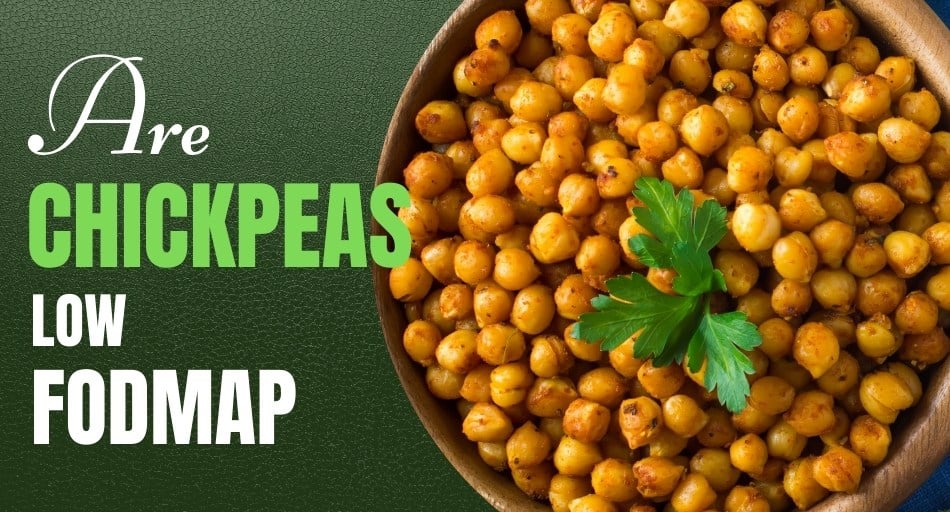
This is important, especially if you suffer from IBS, as FODMAPs can trigger many unpleasant symptoms.
Generally, most vegetables are low in FODMAPS, but some of them might be slightly higher in this type of indigestible carbs.
Chickpeas, for example, are legumes that are notoriously high in FODMAPs.
So, how about chickpeas? Are they high in FODMAPs as well?
Table of Contents
Are chickpeas low FODMAP?
Chickpeas are generally high in FODMAPs when they’re both fresh and cooked. This means that consuming too many of them can cause various symptoms of IBS and other digestive system issues.
So, you might want to limit your consumption of this type of legume on a low FODMAP diet.
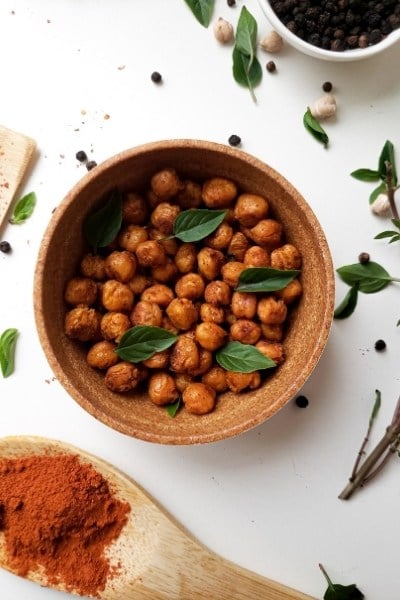
On the other hand, if you can tolerate small amounts of chickpeas, eating them can help you prevent various vitamin and mineral deficiencies.
They’re also high in various plant compounds and fiber, so they keep you healthy.
How high in FODMAPs are chickpeas?
All dried legumes and beans that have to be soaked and cooked before consumption are high in FODMAPs.
So, it’s generally not recommended to consume chickpeas on a low FODMAP diet, especially if your IBS symptoms are severe.
Some people might be able to have some in small servings, though. But when doing that, make sure that you’re really consuming a small serving of about two tablespoons of cooked chickpeas.
More than that can cause digestive issues on a low FODMAP diet.
Are chickpeas good for you?
Chickpeas are not only delicious and versatile but also rich in various nutrients. For example, just a ½-cup serving of cooked chickpeas provides you with 6.3 g of fiber, which is 25% of your daily recommended need for this nutrient.
Because of that, eating chickpeas helps keep you full and prevents overeating. So, adding chickpeas to your diet can help you shed some extra pounds without much of a hassle.
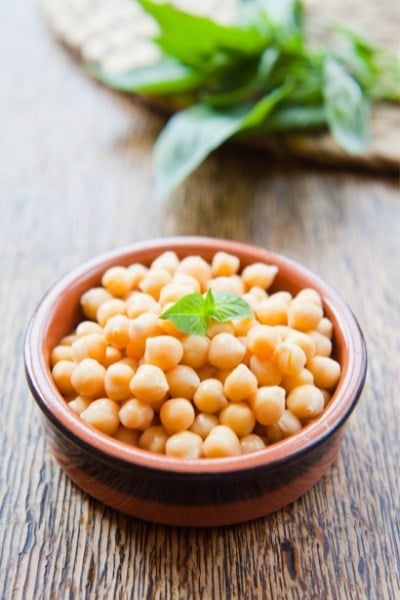
What’s more, the same serving contains 7.4 g of protein, around 15% of your need for this nutrient. The protein in chickpeas helps fuel your muscles and build lean muscle mass.
Because of that, chickpeas are often a great choice for a protein source on a plant-based diet.
A single serving of chickpeas also helps you load up on folate, also known as vitamin B9. This micronutrient is important for the formation of red blood cells.
It also helps your cells grow and stay healthy and is important for the healthy growth of the baby during pregnancy.
Chickpeas are also an excellent source of iron, a mineral that’s crucial for the formation of hemoglobin.
This protein helps transport oxygen throughout your body, reducing the risk of anemia and other cardiovascular conditions.
People who don’t consume meat often tend to be deficient in iron. So, eating chickpeas can compensate for the iron they’re not getting from animal products.
In addition, chickpeas are very rich in magnesium, phosphorus, and manganese. These three minerals are important for bone health as they reduce your risk of bone fractures and osteoporosis.
Unfortunately, many people these days suffer from vitamin and mineral deficiencies. So including vitamin- and mineral-rich foods in your diet can help prevent these.
Aside from the micronutrient content, chickpeas also have a low glycemic index (GI). Because of that, eating them can help keep your blood sugar levels in check, reducing your risk of diabetes.
According to studies, chickpeas’ ability to lower blood sugar levels may also reduce your risk of high cholesterol and heart disease.
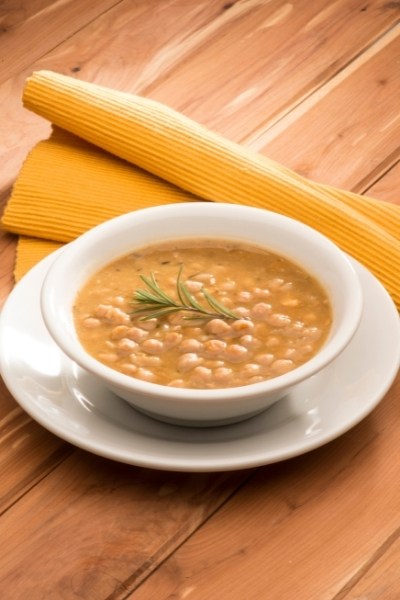
Eating chickpeas also helps you load up on powerful plant compounds. Some of them have anti-cancer and anti-inflammatory properties, which means they reduce your risk of certain types of cancer by suppressing tumor growth.
In the same ways, several vitamins and minerals found in chickpeas have been associated with a decreased risk of breast and lung cancers.
Another plant compound that chickpeas are rich in is choline. This compound is incredibly important for the health of your brain and nervous system, reducing your risk of cognitive impairment.
Getting enough choline may also improve the symptoms of depression and anxiety.
Can you eat chickpeas on a low FODMAP diet?
As long as you stick to the recommended serving sizes, it’s possible to include some chickpeas on a low FODMAP diet.
So, make sure to include about two tablespoons of chickpeas in a single serving.
This might seem like a little, but if you add chickpeas to salads or larger dishes, you can reap wonderful health benefits, such as lots of vitamins and minerals as well as antioxidants.
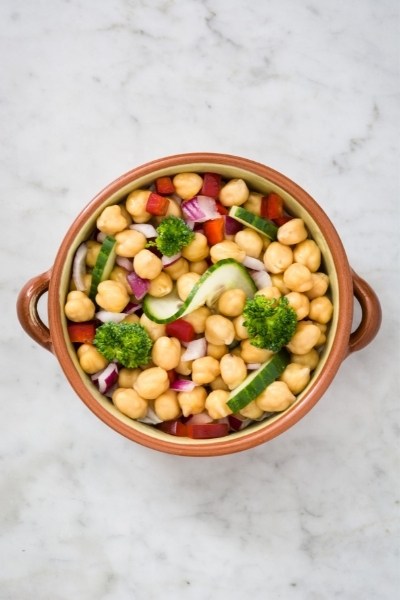
If your digestive system doesn’t tolerate chickpeas and other types of legumes, you can try eating canned varieties.
These tend to be lower in FODMAPs, as most of these indigestible carbs leak into the brine.
So, if you eat drained solids, you should be able to include canned chickpeas on your low FODMAP diet.
Are canned chickpeas high in FODMAPs?
Canned chickpeas are lower in FODMAPs than cooked chickpeas. This is because a large portion of the FODMAPs found in chickpeas leaks into the brine when they’re canned.
So, when you drain them and pour out the brine, you’re not ingesting as many FODMAPs.
Canned chickpeas are still a great source of nutrients, so they can safely replace cooked chickpeas in any healthy diet.
Just make sure to watch out for those with added sugars or salt, as they are less healthy for you.
Conclusion
Cooked chickpeas tend to be high in FODMAPs, so they should be limited or avoided on a low FODMAP, IBS-friendly diet.
If you do choose to consume chickpeas, make sure to stick to a small serving to avoid digestive system issues.
Alternatively, you can eat canned chickpeas, which are lower in FODMAPs.
Eating chickpeas is beneficial, though. They’re loaded with vitamins and minerals, which means that adding them to your diet can prevent micronutrient deficiencies.
So, including chickpeas in your meals can be a great idea.
Sources: Nutrition Data, PMC, Wiley Library, and National Library of Medicine
